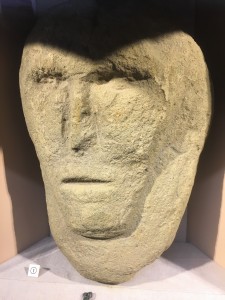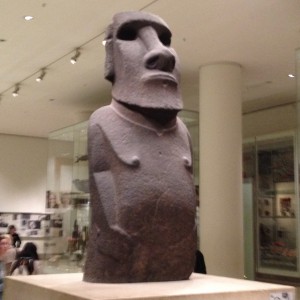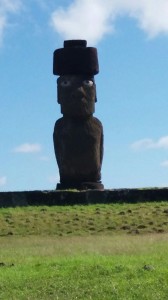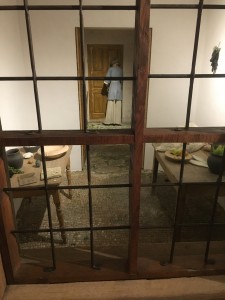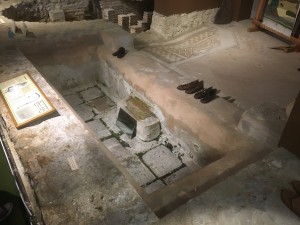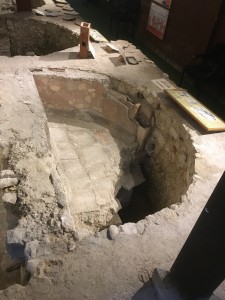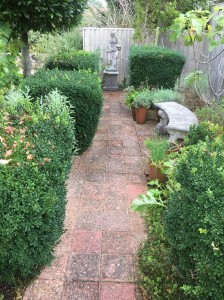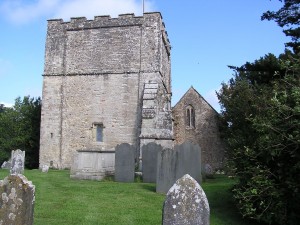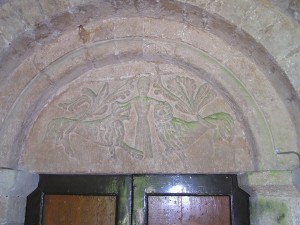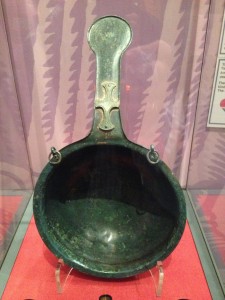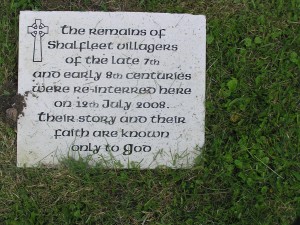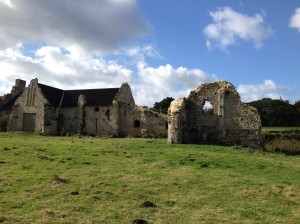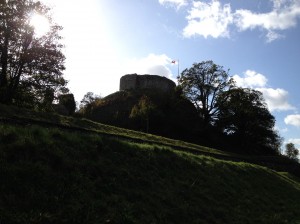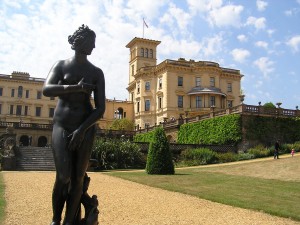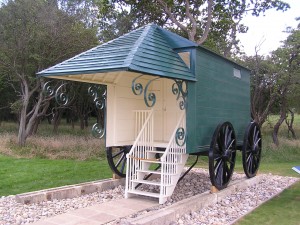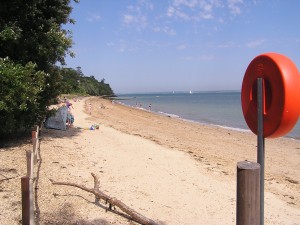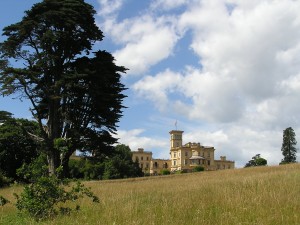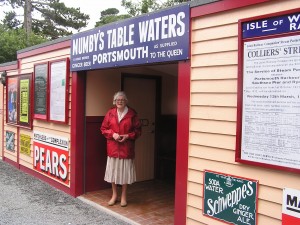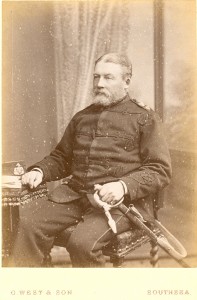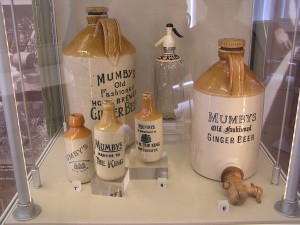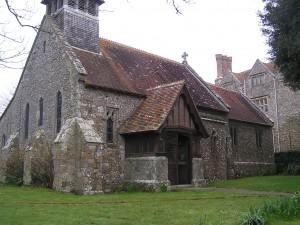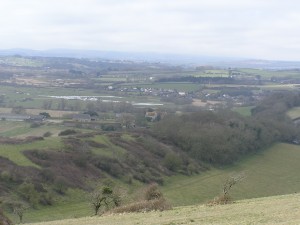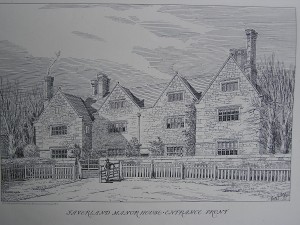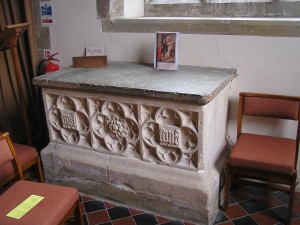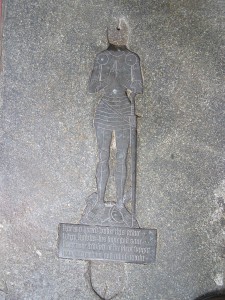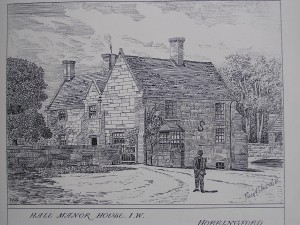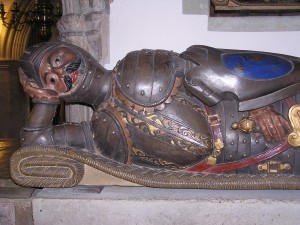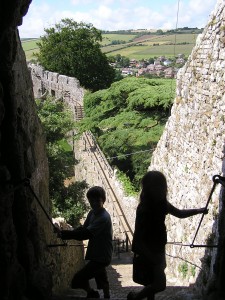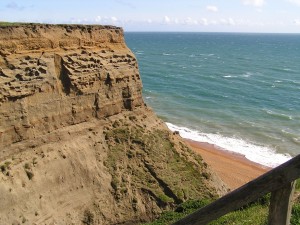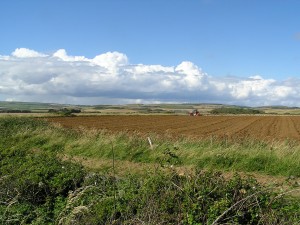The small museum at Newport Roman Villa includes something quite remarkable, a carved, near life-sized stone head that is every bit as powerful, mysterious and evocative as any of the Easter Island heads – and considerably older too, as it is thought to date from the late Iron Age or early Roman period. The head was discovered at Luccombe Chine, one of the prettiest places on the Island, but otherwise is entirely inscrutable.
Archive for the ‘The Isle of Wight’ category
Easter Island or Isle of Wight? The Luccombe Chine Head
September 9th, 2018The Red Roman Villa on Cypress Road, Newport, Isle of Wight: An Appreciation
September 9th, 2018Among the undistinguished suburban villas on Cypress Road, Newport, is a gem of an archaeological site. It was discovered there in 1926, while foundations were being dug for a garage.
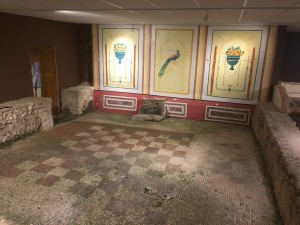 The extremely well-preserved remains are of a Roman villa that is thought to date from the late 270s, long before the existence of any town on the Isle of Wight. It was a single-storey building with a corridor, or possibly open verandah, at the front, giving access to a series of rooms and to wings on each side. It faced southwards onto a courtyard that would have been enclosed by farm buildings. Without the modern streetscape, there would have been pleasant views across open country to the surrounding hills.
The extremely well-preserved remains are of a Roman villa that is thought to date from the late 270s, long before the existence of any town on the Isle of Wight. It was a single-storey building with a corridor, or possibly open verandah, at the front, giving access to a series of rooms and to wings on each side. It faced southwards onto a courtyard that would have been enclosed by farm buildings. Without the modern streetscape, there would have been pleasant views across open country to the surrounding hills.
The plan of the house can clearly be read on the ground, as the stone bases of the walls are virtually intact. Above them, the timber frame of the house was infilled with wattle and daub, proofed with limewash and – it seems – painted red. The building was roofed with heavy slabs of Bembridge limestone, many of which, pierced with single holes for nails, were found on the site, along with the arched tiles that once finished the roof-ridge. Fragments of window-glass reveal that at least some of the windows were glazed. For others, wooden shutters probably sufficed.
The interior walls were brightly painted, and some of the rooms had elaborate mosaic floors. As if these were not luxuries enough, the entire west wing was a purpose-built bath-house, with the classic sequence of a frigidarium (‘cold room’) leading into a tepidarium, sudatorium and caldarium (‘warm room’, ‘sweat room’ and ‘hot room’). These last three rooms were heated by an underfloor hypocaust, which depended on the stoking by a slave of a furnace outside. The pools are of similar size to a modern hot-tub – and opportunities for serious pampering.
The exterior walls of the bath-house wing may have been entirely of stone, while the three heated bathrooms were crowned by white plastered domes (domed ceilings were necessary to reduce condensation), constructed from the tufa blocks that were discovered in abundance by the excavators. The front room of the opposite (east) wing also benefited from underfloor heating, with hot air circulating from a separate furnace.
It is extraordinarily easy to make a mental leap back in time, to see this place as it once was and to marvel at the level of luxury that was enjoyed here. The owners were no doubt indigenous Britons who had flourished under Roman rule and taken full advantage of its opportunities. Within about fifty years, however, the way of life here had declined to such an extent that fine mosaic floors had been taken up, and the grandest room of the house turned into a smithy. In the ensuing century, it is perhaps Saxon or Jutish raiders who were, literally, the death of the place, for the skull of a woman in her early thirties, with two huge cracks in it, was found in the corner of one of the rooms, into which her decapitated head had been heartlessly tossed.
Shalfleet: Church Tower or Castle Keep?
August 28th, 2017The Tower of Shalfleet Church is the oldest on the Isle of Wight, and the most remarkable. Were there not a church attached to it, one would assume it was a defensive keep. The walls of this massive structure are over five feet thick, and there was originally no means of access from ground level: one had to climb an external ladder and scramble over the parapet. It is a structure that takes one’s breath away and has been described as ‘practically unique’. (Percy Stone, The Architectural Antiquities of the Isle of Wight, II, London 1891, pp.51-2.)
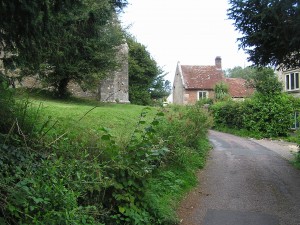
The Old Vicarage, Shalfleet: was it the site of the Saxon church? The Norman foundation is on the left.
The Tower was built in the later eleventh century, probably between 1070 and 1085, and may have been positioned at a distance from the Saxon church, the cemetery for which was in the garden of the Old Vicarage. (Ruth Waller, Archaeological Excavations in Shalfleet (Shalfleet, 2008.)
William fitz Osbern, the Conqueror’s cousin and close friend, to whom he had granted the lordship of the Island, had presented the manor of Shalfleet to Gozelin fitz Azur, his own subordinate knight who had probably fought beside him at Hastings, while the church was part of his endowment to the Abbey of Lyre in Normandy. The Tower that they quickly raised would not have been free-standing for long, for it was soon connected to a new church on the present site, with an arch giving access to the Tower from the nave. Apart from the Tower, their North Door has survived the subsequent alterations to the building, with its ‘quaintly carved tympanum … an ordinary Romanesque enrichment’. The best guess is that the curious scene of a man with two lions represents Daniel in the Lions’ Den.
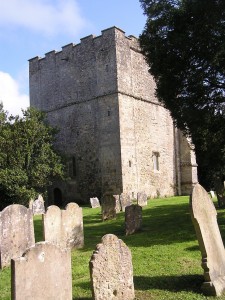 It has been suggested that a tower of such strength was intended as a refuge, for Shalfleet, with its flat shore, was particularly vulnerable to raiders from France (Stone, II, p.52; Brian Mead, The Church of St Michael the Archangel, Shalfleet, 2004). However, what Frenchman in the 1070s would have dared to invade the newly-annexed territory of William the Conqueror, given that he was the ‘strong man’ of northern France and notoriously swift in his retribution? Moreover, how would the frail and elderly have been expected to scramble up the Tower in times of danger? Although it undoubtedly served later as a defence against the French (and was equipped with its own three-pounder gun until 1779), it seems to me most unlikely that that was its original purpose.
It has been suggested that a tower of such strength was intended as a refuge, for Shalfleet, with its flat shore, was particularly vulnerable to raiders from France (Stone, II, p.52; Brian Mead, The Church of St Michael the Archangel, Shalfleet, 2004). However, what Frenchman in the 1070s would have dared to invade the newly-annexed territory of William the Conqueror, given that he was the ‘strong man’ of northern France and notoriously swift in his retribution? Moreover, how would the frail and elderly have been expected to scramble up the Tower in times of danger? Although it undoubtedly served later as a defence against the French (and was equipped with its own three-pounder gun until 1779), it seems to me most unlikely that that was its original purpose.
Was it not, rather, an outpost of the lordly control that was now being exercised from Carisbrooke Castle? Conspicuously more solid and expensive than the usual motte and bailey, a commission worthy of the Island’s central authority and ideally placed to hold sway over the West Wight, might it have been intended not to shelter the local populace, but to cow them into submission?
The Shalfleet Skillet: A Story of Genocide on the Isle of Wight
August 27th, 2017The Odinist Fellowship, a body representing 2,000 so-called ‘pagans’, has applied for reparation from the Church of England ‘for its former crimes against the Odinists’ (‘We want our stolen churches back, pagans tell Archbishop’, The Sunday Telegraph, 27 August 2017). It suggests a public apology and the symbolic handing over of two churches, one from the diocese of Canterbury, one from that of York. The Bishop of Chichester has sensibly responded by saying ‘As yet I am unconvinced as to the strength of Odinist faith in these parts’; and it is difficult to see how these cranks can in any way be considered the heirs to the dispossessed pagans of the past, or even to have any coherent grasp of their religion. There is no doubt, however, that the Christianisation of England was an often brutal process, as the following story reveals.
The copper-alloy saucepan or ‘skillet’ discovered in 2005 in a shallow ditch at Shalfleet on the Isle of Wight has been dated to the late seventh century A.D. and, its long handle decorated with a cross, is the earliest Christian object to have been found on the Island. It is in remarkably good condition, given its age, and is associated with a particularly dramatic episode in Island history.
In 686 A.D, the Jutish kingdom of the Isle of Wight, then a thinly-populated place of 1,200 families, had been invaded and captured by the Saxon Caedwalla, King of Wessex. Though an uncommitted Christian, Caedwalla had, according to Bede, pledged ‘the fourth part of the land and of the spoil to the Lord, if he took the Island’, which ‘till then was given over entirely to idolatry’. Caedwalla was himself wounded in the fierce assault, his aim being ‘by merciless slaughter’ to destroy the entire population of the Island and to re-colonise it with his own people. His motives, clearly, were political rather than religious, but he was prepared to pay a high price for what was then the most impressive spiritual support on offer. (Bede, The Ecclesiastical History of England, IV, xvi, trans. A.M. Sellar (London, 1907).)
When the two young brothers of the defeated King Arwald fell into his hands, they, too, were put to death, despite having been hurriedly baptised. The genocidal Caedwalla was nevertheless true to his word. The promised quarter of the spoils was duly handed over to St Wilfred, the exiled ‘Bishop of the Northumbrian peoples’, who is said to have landed at Bembridge and to have set up his first church at Brading. Thus was England’s last pagan enclave brought to Christ.
The skillet was no doubt used by the first generation of Christian colonists in Shalfleet (‘shallow stream’ to the Saxons), perhaps in their religious ceremonies. (They were only the latest wave of incomers, for Bronze-Age chiefs had been buried in mounds to the north and south of the village and the Romans had come in their turn to build houses there.) In 2005, excavations in the garden of the Old Vicarage revealed the remains of eight of these early Christians, their skeletons orientated east to west, as was proper for people of their religion. The bones, both of men and women, were in a poor condition, in death as in life. Arthritic spines are suggestive of, literally, back-breaking working conditions on the land; pitted eye-sockets indicate dietary deficiency; all had suffered injuries of some sort (though not obviously in battle) and had rotten teeth. Half had died in their twenties or early thirties and the other four may have made it to forty-five. One of the skeletons has been carbon-dated to the years between 660 and 734 A.D., which fixes it firmly in the period described by Bede. (Ruth Waller, Archaeological Excavations in Shalfleet (Shalfleet, 2008.) The burials are evidence of the swift realisation of Caedwalla and Wilfred’s policy to pacify and Christianise the Island.
The site of the Saxon cemetery was subsequently developed for housing. In July 2008, the displaced skeletons were fittingly reinterred in the adjacent churchyard. A stone, with a touching inscription, marks the spot. The skillet, which had been discovered by a metal-detectorist, was bought by the Isle of Wight Heritage Service and can be viewed in the Museum of Island History in Newport’s former Guildhall, for the price of a mere £2.00.
The Normans – Conquest and Legacy: The Isle of Wight
November 17th, 2014A short film to promote my latest lecture, ‘The Normans – Conquest and Legacy’, can be viewed on my new Youtube page – https://www.youtube.com/watch?v=n0xejJtoUuk.
In the film, I visit four locations on the Isle of Wight – Binstead Church, Carisbrooke Castle, the ruins of Quarr Abbey and Brading Church – to demonstrate that the physical impact of the Normans was considerable, even in the remotest corners of our landscape.
Why might the Tower of London and Winchester Cathedral be the pride of the Isle of Wight? What saucy reminder of themselves did the Normans leave over a church door? Why was a powerful Island abbey the legacy of a marauding Norman giant who was hardly a model Christian? Why is the descendant of another Norman settler remembered as a swarthy Turk? These and other questions are answered in the film.
It was shot by Roger Lowe on 21 October 2014, while England was still being ravaged by the tail-end of Hurricane Gonzales – hence the dramatic skies and the slightly windswept appearance of the presenter!
Queen Victoria’s Private Beach at Osborne, and the Pink-Eyed Cadets of the Royal Naval College
August 5th, 2013I have been to Queen Victoria’s private beach at Osborne, on the Isle of Wight, to swim. English Heritage, who manage the estate, have restored the alcove or exedra, colourfully decorated with blue and pink tiles, which she favoured for letter-writing and sketching. The Queen’s bathing machine, also restored – after lengthy service as a chicken coop – is displayed there, a very superior construction akin to a small house. Deck chairs may be hired, there are regular Punch and Judy shows, brass bands occasionally perform and there is a pleasant café with changing facilities.
It was here that Queen Victoria bathed for the first time, when she was in her late twenties. In her journal for 30 July 1847 she writes: ‘Drove to the beach with my maids and went in the bathing machine, where I undressed and bathed in the sea (for the 1st time in my life)… I thought it delightful till I put my head under water, when I thought I should be stifled.’
In fact, the sea here is so shallow, except at the highest tides, that one could almost walk to Portsmouth. As a swimming place it is ideal for young children, as there is little danger of their getting out of their depth. Queen Victoria’s own children played happily on the beach for hours and had swimming lessons from Prince Albert, a firm believer in the health-giving properties of sea-bathing. Although the Solent is a narrow strait, the view from here reminded him of the Bay of Naples.
I wondered whether my grandfather, a cadet at Osborne during the First World War, would also have swum here. In 1902, Edward VII presented Osborne to the nation. A year later, a Royal Naval College was opened in the former stables, the main house being put to use as a convalescent home. The accommodation was damp and spartan, a suitable training ground for the nation’s martial élite. (These included Prince George, later the Duke of Kent, who was my grandfather’s servant.) The College was to become notorious for its epidemics of ‘pink eye’, a minor but unpleasant infection, treatable with drops, that was said to have been left behind by the horses.
Disappointingly, I discover that there were no opportunities to swim, nor indeed swimming lessons, in my grandfather’s day. There was no pool, and the Admiralty had banned swimming in the Solent, on the improbable grounds that it was unsafe! Swimming lessons were deferred until the boys arrived at Dartmouth, which had a pool, though I suspect my grandfather would already have been a competent swimmer.
One of the delights of visiting this beach is the path from the main house that leads to it. A near contemporary of my grandfather writes: ‘the grounds which formed the park of Queen Victoria’s favourite country home … were quite lovely. Though we were not allowed to approach the house, on half holidays and Sunday afternoons the paths through the woods and down to the sea were open to us, and in the infrequent intervals between organised games I used to love to wander there. But our lives were so strictly circumscribed and controlled that these opportunities were rare.’
Osborne House itself was off limits. Another former cadet recalled: ‘Funnily enough, while I was at Osborne I never saw Osborne House. I never caught sight of it at all and we were quite close by, just through a few trees and shrubs and things.’
Personally I am much taken with Prince Albert’s Italianate fantasy, which appears at its best under a blue sky. I feel sad for Queen Victoria, fussing about with her maids and bathing machine and voluminous costume, failing to enjoy the sense of liberation that comes with even a moderately wild swim. She should have been as untramelled as the voluptuous statuary that surrounded her at Osborne.
(See Michael Partridge, The Royal Naval College, Osborne: A History, 1903-21, Stroud 1999, pp.29, 30, 116-17, 105-6, and
http://www.english-heritage.org.uk/daysout/properties/osborne/beach/history-of-the-beach/
Charles Mumby & Co., Gosport and Portsmouth: Memories Evoked by the Isle of Wight Steam Railway
July 18th, 2013To travel on the Isle of Wight Steam Railway is to step back in time. I love the waiting room at Havenstreet with the piles of leather suitcases. The redundant station at Wootton has been reconstructed and looks like a typical country terminus of a hundred years ago.
The station building itself is an authentic recreation of the pre-1920s one at Havenstreet, based on a photograph from 1905. The building is festooned with the same notices and advertisements as in the photograph, the most prominent being one for ‘Mumby’s Table Water and Home Brewed Ginger Beer, Portsmouth, as Supplied to the Queen’. I feel a flush of pride, as this was my grandmother’s family firm.
It was founded by Charles Mumby (1823-1895) from Chatteris in Cambridgeshire, a pharmaceutical chemist, who settled at Gosport in 1844. An ancient sea-port that juts into Portsmouth Harbour, Gosport was a ‘well-built, handsome town’ with flourishing, thrice-weekly markets and a railway terminus, contained by ramparts and a moat dating from the 1750s.
A remarkably personable and impressive young man, rather short, but muscular and very good-looking with his wavy blond hair, Charles went into business on his own in 1849, at 47 High Street. He was keen to diversify and, applying his skill with concoctions, soon set himself up as a manufacturer of mineral waters. To ensure the necessary supply of water, he sank a large bore-hole or artesian well in the large yard at the back of his shop, which had a rear access from North Street. At 384 feet, the well was deep enough to reach the aquifers in the chalk subsoil, for Gosport is almost surrounded by the sea, and penetrated by a number of salty creeks.
His next step was to instal elaborate machinery to increase the output of manufactured ice. The fame of Charles’s soda water, ginger beer and lemonade spread rapidly across the south of England and within a few years he was supplying large quantities to both the army and the navy, which were traditionally victualled from Gosport. His crowning glory was to receive a Royal Warrant from Queen Victoria, Mumby’s being one of only four brands of mineral-water that were served at her table.
Charles Mumby was a classic Victorian entrepreneur, a Nonconformist, as many of them were, commended for his ‘marvellous activity and energy, admirable business talent, sterling honesty and genuineness of purpose’. By then a rich and influential man, he became in 1864 a member of the Board of Trustees that governed the town. He was to serve for thirteen years (from 1881 to 1894) as Chairman of the Board, overseeing a vast improvement in the borough. Streets were widened, the old fortifications removed. Areas of open ground were acquired for recreational purposes, and a Free Library was created.
Charles became a Poor Law Guardian, a magistrate, a County Councillor for Hampshire, and sat on innumerable public and social committees. The manufacture of mineral waters continued at his original premises in the High Street, and an office was opened up at Portsmouth, first at 71 St George’s Square, then, from the late 1870s, at 34 The Hard. Charles was a founder member of the National Liberal Club (where he rubbed shoulders with Gladstone) and Colonel of his local territorial unit, the Third Hampshires.
Charles Mumby retired from the active management of his business in 1885. The chemist’s shop, reduced by this time to a sideline, was given up. His eldest son, Everitt, was appointed managing-director of the mineral-water company, from which he derived a good living, though he had neither the capacity nor the inclination for a career in business. It was Everitt who oversaw the public flotation of the company in 1898, an event which greatly enriched the family, and further allowed him to indulge his penchant for travel.
Everitt Mumby died in 1906, leaving a third of his majority holding in the company to his only son, Cyril, although the young man would have preferred a career in the army and held the rank of Captain in a militia regiment. When Cyril Mumby was appointed managing-director in 1907, the firm employed about a hundred hands (manual and clerical) in its two factories and had capital of £45,000. He installed himself in the finest house in Gosport, Stanley House (later known as ‘The Hall), next to Holy Trinity Church, on the edge of Portsmouth Harbour, and was the owner of an expensive motor-car and a yacht.
Cyril’s good fortune ended in 1914. Serving with the First Battalion the Lincolnshire Regiment, he was severely wounded at the Nonne Bosschen. After the war, he was to make a new life on the Continent, resigning his directorship of the company in 1924. He died in 1938, by which time the company had been sold out of the family, though it continued until the 1960s to trade under the Mumby name. My mother recalls seeing its advertisements at the cinema in her youth.
The prosperous, elegant Gosport that the family had helped to create was destroyed by a combination of the Luftwaffe and post-war planners. Nothing remains of the firm’s headquarters at 47 High Street, nor of its offices on Portsmouth Hard. Stanley House, my grandmother’s childhood home, was demolished in 1965 by a philistine local authority, which had already razed most of the surrounding area to the ground. The site is now an open space, hedged by two hideous tower blocks that are familiar landmarks to anyone passing in or out of Portsmouth Harbour.
(See The Isle of Wight County Press, 25 May 2012. The full story of the Mumbys is in my forthcoming book, The Incredible Journey of Victor Hugo’s Dog.)
The Norman Colonisation of the Isle of Wight. Part 2: The De Aula Family of Yaverland and Arreton
July 12th, 2013The coterie of Norman knights who surrounded Baldwin de Redvers, Earl of Devon and lord of the Isle of Wight, are revealed in the foundation charter for Quarr Abbey, dating from the 1140s. Many were granted estates on the Island and settled there, giving rise to all the most prominent local families of the medieval period. Among them were the Wavells and the Oglanders, who persist on the Island to this day.
Together with Robert d’Orglandes, Godfrey de Wauville and others, a certain Warin de la Halla is mentioned in the charter, having endowed his chapel of St Nicholas to the abbey. He was clearly in favour with Baldwin, from whom he held the lordship of Bampton in Devon, as well as land on the Isle of Wight, south of Carisbrooke Castle.
Warin was ancestor of the ‘De Aula’ family of Yaverland (meaning ‘Overland’ in the Island dialect), in the parish of Brading. As its name suggests, Yaverland was virtually isolated on a spit of land under Bembridge Down. Cut off from the parish church by the tidal Brading Haven, the family built a chapel of ease there, with fine Norman features, alongside their sturdy manor-house of stone.
The male line at Yaverland died out in the reign of Edward I. Eleanor, daughter and heiress of Sir Thomas De Aula, married William Russell, who built the causeway connecting the ‘overland’ with Brading. It was a key moment in the history of East Wight: part of the Haven was thus enclosed, the first step in the process of reclamation that was to be completed in the nineteenth century.
The Yaverland estate was sold by the Hatfields, descendants of the Russells, in 1553, and the manor-house rebuilt, in its present form, in 1620, on the six-foot-wide Norman footings. Mainly of Wight stone under a red-tile roof, it occupies a stupendous position and is one of the finest houses on the Island, a monument in its way to the Norman Conquest of England. The little chapel beside it, built by the De Aulas, is still used for services.
Writing in the seventeenth century, Sir John Oglander says that members of the De Aula family favoured Godshill for burial. Others, no doubt from the main branch, were buried at Brading. The north chapel of Brading Church, reconstructed after a fire in the late-fifteenth or early-sixteenth century, is a monumental chapel to the family and is still known by their name. It contains the tombs of William and Elizabeth de Aula, their name corrupted to ‘Howley’ in the vernacular tongue. ‘Both are altar tombs, bearing the Tudor rose, and are inscribed, in rough sixteenth century letters,
Jhu have merci on Wylyam Howly’s sowl. Amen. MCCCCCXX.
Helizabeth hys Wyf.’
Others of the line settled at Arreton. The manor of Arreton was part of the original endowment to Quarr Abbey and in the parish church, rebuilt by the first monks in the best Norman style, the ‘only remaining pictorial brass is that of Harry Hawles, an honourable member of the ancient De Aula family, who probably held office under Montacute, Earl of Salisbury, Lord of the Island from 1386 to 1397, under grant from Richard II. The head is missing, otherwise the figure is perfect, and is a good example of the period.’
Harry Hawles is thought to have lived at Hale, the small, stone manor-house in the parish that in 1686 was occupied by the descendant of another prominent Norman family. George Oglander had inherited the Oglander name and seal, but was mystified when asked, by visiting heralds, to explain his connection with the Nunwell branch. These people were by then deeply rooted in the soil, bastardising their names, conversing in the local speech and forgetful of their origins. It is a matter of regret that there are no ‘Howleys’ or ‘Hawles’ in the current phone book. One would be surprised, however, if they had not left a fair distribution of female-line descendants among the existing Island population.
In the same way, the Norman colonisers have even infected the local speech. There is a pub at Brading called the Bugle, and another at Newport, which, during the Civil War, was the headquarters of the Parliamentary Commissioners, who included a debased Wavell. In the Island dialect, the word does not mean ‘trumpet’, but ‘steer’. It derives from the Latin word buculus, and is yet another legacy of the Norman Conquest.
(See S.F. Hockey, Quarr Abbey and its Lands, Leicester 1970, pp.7, 10, 257; Percy Stone, The Architectural Antiquities of the Isle of Wight, I, London 1891, pp.7, 15, 69, 87, 120; G.D. Squibb ed., The Visitation of Hampshire and the Isle of Wight, London 1991, p.88; Yaverland Manor Estate, Dreweatt Neate Sale Particulars.)
The Norman Colonisation of the Isle of Wight. Part I: The Founding of Quarr Abbey and the Oglanders of Nunwell
May 30th, 2013Richard de Redvers (from Reviers in Normandy) was a loyal supporter of Henry I, who received as his reward lands in Devon and Hampshire and the lordship of the Isle of Wight. The likely builder of the polygonal stone keep and inner curtain wall at Carisbrooke Castle (his Island fortress), he probably also founded the borough of Newport, which would previously have been little more than an obscure port.
Richard de Redvers died in 1107 and was succeeded by his son Baldwin, eventual Earl of Devon. Baldwin was a figure of national significance, an opponent of King Stephen, but he left his own mark on the Island’s history by his foundation, in 1131, of the Abbey of Quarr.
Nearly two decades in the building, Quarr was colonised by Cistercian monks from the Abbey of Savigny, near Avranches, and endowed by Baldwin with estates including the manors of Arreton, Haseley, Combley and Newnham, all on the Isle of Wight. Meanwhile, Baldwin continued to maintain close links with his native Normandy, where he was lord of Néhou, Reviers, Amfréville and Varaville and, from 1135, of Douvres in the Bessin. His father, Richard, had been buried in the Abbey of Montebourg (on the Cotentin peninsula), of which the Redvers family were the protectors and benefactors.
Baldwin himself, who was harsh, warlike, ambitious and unforgiving, chose to be buried at Quarr, where his supposed tomb was excavated in 1891. The remains had been disturbed, but included the thigh bone of ‘a man of abnormal stature’. One can imagine Baldwin towering above his followers as they gathered to witness the foundation charter of the Abbey, intending by his beneficence ‘to forestall the calamity of our dissolution … and to investigate to our profit how we may attain pardon in the presence of the divine majesty’. According to Sir John Oglander, writing in the mid-1600s but relying on sources now lost, ‘every inhabitant in this Island wase in somethinge or other a helpor and furtheror of ye said woorke’. He relates that the Abbey Church was consecrated on 1 June 1150 by Henry de Blois, Bishop of Winchester, and marked by ‘a greate and solemn feast theyre for ye whole Island, for ye finischinge of so goode a woorke’. (Percy Stone, The Architectural Antiquities of the Isle of Wight from the XIth to the XVIIth Centuries, Vol. I, London, 1891, pp.31 et seq.)
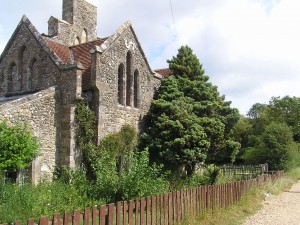
This 18th-century cottage, built amid the abbey ruins, incorporates masonry from the former church, which was on the right of the picture
The foundation charter for Quarr is undated (probably 1141 – 4) but records the construction of the abbey that was then in progress. From this document (a rare example of a ‘diploma’ charter), it is apparent that Baldwin surrounded himself with knights from the Cotentin, men like Robert of Orglandes (only 7km from Baldwin’s chief lordship at Néhou), Warin of Halla and Godfrey of Vauville, none of whom, incidentally, could write his own name. One imagines that they were pretty rough company, the sons, no doubt, of thuggish participants in the Norman Conquest and perhaps also in the First Crusade. Baldwin encouraged them with grants of land to settle on the Island and their descendants ‘will appear constantly in the later story of the abbey, as the local aristocracy during the medieval period: the Gernons or Vernons of Chale, the Trenchards of Shalfleet, the de Lestra of Niton, the Oglanders of Nunwell, the de Barnevilles of Chale and especially the de Insula family, destined to a rank of great local importance. The names of many serve to remind us how closely the history of the Isle of Wight was linked to that of the Cotentin peninsula as a result of the Conquest.’ (S.F. Hockey, Quarr Abbey and its Lands, 1132 – 1631, Leicester University Press, 1970, pp.9-10.)
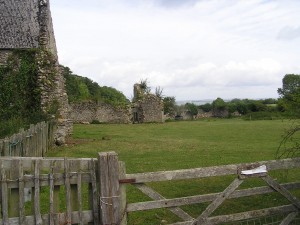
Quarr Abbey was dissolved in 1538 and quickly dismantled. Only the former Dorter or Dormitory block, on the left of the picture, survives intact
Sir John Oglander, the proud descendant of Robert of Orglandes, writes of the prestige of the Abbey of Quarr, where scions of the best Island families were eager to obtain positions. To hold an office such as treasurer, steward, chief butler or even rent collector was considered a great honour. ‘One of my own auncestors,’ he writes, ‘was theyre steward, and theyre dyed.’ Sir John Oglander himself neatly exemplifies the enduring impact of the Norman Conquest. Blissfully settled at Nunwell, the estate granted to his ancestors by the de Redvers family, he lorded it over an indoor staff of thirteen people, whose wages amounted to a meagre £40 per annum, compared to nearly £700 that he lavished on himself and his dependants. On the other hand, Sir John was deeply rooted and assimilated, so that even ‘in the way he wrote you can hear his Isle of Wight accent and manner. Barns, fields and trees were all “him” and “he”, “fallow” fields were “vallow” and ferny grounds “vearnie grounds”.’ (Adam Nicolson, Gentry: Six Hundred Years of a Peculiarly English Class, London 2011, pp.111, 115.) Sir John had been educated at Balliol College, Oxford, and at the Middle Temple, yet he instinctively conversed in the local dialect. To refer to inanimate objects as ‘he’ is still an Island peculiarity – or was when I was growing up there – where, they used to say, ‘everything but a tom-cat is a “he”’.
The Oglanders (or, at least, their female-line descendants, who have taken the name) still hold part of their ancestral estate at Nunwell. Their name seems to have appealed to Evelyn Waugh, an Oxford contemporary of Denys Oglander, whose ‘Mrs Stuyvesant Oglander’ has a walk-on part in Brideshead Revisited. Another notable Norman family that persists on the Island is that of Wavell, the descendants of Godfrey of Vauville, who are the subject of an earlier blog (http://www.rupertwilloughby.co.uk/archives/999). It would be surprising indeed if the Norman genes were not widely distributed among all levels of Island society.
The Isle of Wight’s Wildest Swimming: Whale Chine, Vauville in Normandy and the Wavells of Atherfield Farm
August 10th, 2012Whale Chine is a spectacular ravine in the cliffs on the south side of the Isle of Wight. Other examples of such clefts – the word ‘chine’ is peculiar to the dialect of Dorset and the Island – are the better known Blackgang and Shanklin Chines.
Whale Chine is reached from a car park on the Military Road, which is notable for its grand vistas. Some of the greatest wild swimming of my boyhood and youth was to be had there. To descend to the beach, by means of a steep, rickety wooden staircase and narrow path, was an adventure in itself, for the chine is 140 feet deep.
Usually weighed down by a picnic basket, one was overpowered by the grandeur and timelessness of one’s surroundings. The cliffs here abound with the fossilised remains of prehistoric oysters, ammonites and lobsters. The stony beach is steeply shelved, so swimmers 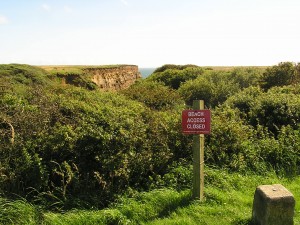 at high tide are soon out of their depth. The swell is considerable. So remote and challenging an environment was appealing to naturists, whose presence occasioned much sniggering among us youngsters – all those corpulent bank managers – though swimming naked is, of course, the wildest swimming of all, and they added to the exoticism of the place.
at high tide are soon out of their depth. The swell is considerable. So remote and challenging an environment was appealing to naturists, whose presence occasioned much sniggering among us youngsters – all those corpulent bank managers – though swimming naked is, of course, the wildest swimming of all, and they added to the exoticism of the place.
Since 2005, the steps having fallen into disrepair, the beach at Whale Chine has been completely inaccessible from the landward side. It seems the only way of getting there is by sea. The picture at the top was taken the other day from the head of the wooden staircase and evokes many memories.
Whale Chine appears not to have been named for the marine mammal, as I always supposed, but for the Wavell family of nearby Atherfield Manor, who farmed the land up to the edge of the 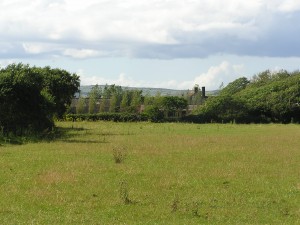 chine. The family left their mark on the place during less than a century of occupation. They are said to have bought the estate in 1557 (from Sir Thomas Trenchard) and to have relinquished it in 1636 (A.D. Mills, The Place-names of the Isle of Wight). The photograph on the left is a distant view of the manor-house, less than half a mile inland – a solid, L-shaped building of stone. From a clearer picture in C.W.R. Winter, The Manor Houses of the Isle of Wight (Wimborne, 1987, p.186), I deduce that it also dates from the time of the Wavells.
chine. The family left their mark on the place during less than a century of occupation. They are said to have bought the estate in 1557 (from Sir Thomas Trenchard) and to have relinquished it in 1636 (A.D. Mills, The Place-names of the Isle of Wight). The photograph on the left is a distant view of the manor-house, less than half a mile inland – a solid, L-shaped building of stone. From a clearer picture in C.W.R. Winter, The Manor Houses of the Isle of Wight (Wimborne, 1987, p.186), I deduce that it also dates from the time of the Wavells.
These Wavells are a very old Island family. They are recorded there since 1300, when a Roger Wavill witnessed a charter at Afton, near Freshwater. A century later, Adam Wavill was witness to a grant of land at the same place. Their farming descendants had no airs about them and are listed in 1606 among the yeomen of the Island.
Thomas Wavell, who sold Atherfield in 1636, had settled at Limerston, elsewhere in the parish of Brighstone. He served during the Civil War as a major in the Royalist army, but another Wavell was for Parliament, and sat on the ‘Committee of Safety’ that it imposed on the Island. The leading Royalist there, Sir John Oglander, was to deplore the arbitrary government of ‘Ringwood of Newport, the pedlar, Maynard the apothecary, Matthews the baker, Wavell and Legge, farmers’, who ‘overruled Deputy Lieutenants and Justices of the Peace’. He felt this to be contrary to the natural order of things.
Little did Sir John know that the despised Farmer Wavell was assuredly the male-line descendant of a knightly Norman immigrant from the time of the Conquest, which was the proudest boast of his own family (C. Aspinall-Oglander, Nunwell Symphony (London, 1945), pp.11-12, 40, 104). Sir John’s descent was from the lord of Orglandes, near Valognes; Wavell’s was, almost certainly, from the lord of Vauville, also on the Cherbourg peninsula. In the late eleventh century, William de Vauville or ‘Wavilla’ is mentioned in charters in both Normandy and England. Subsequent generations took root in Sussex, Bedfordshire, Somerset and, it seems, the Isle of Wight. From Whale Chine they would unwittingly have looked across the Channel towards their ancestral home, forgetful of their origins and of their former knightly rank, even more than the Durbeyfields of Hardy’s novel.
 Major Thomas Wavell’s son Richard (1633-1705), sometime of Egham and London, was a celebrated nonconformist pastor, and great-grandfather of Dr William Wavell of Barnstable, after whom the element ‘wavellite’ is named. Three generations of William’s descendants were all educated at Winchester College and became soldiers, the last being Field Marshal Archibald, First Earl Wavell of Cyrenaica (pictured left), the wartime Viceroy of India. (L.G. Pine, They Came with the Conqueror (London, 1966), pp.46-8; G.E. Wavell, ed. L.G. Pine, The House of Wavell (MS in British Museum); Burke’s Peerage 1949.)
Major Thomas Wavell’s son Richard (1633-1705), sometime of Egham and London, was a celebrated nonconformist pastor, and great-grandfather of Dr William Wavell of Barnstable, after whom the element ‘wavellite’ is named. Three generations of William’s descendants were all educated at Winchester College and became soldiers, the last being Field Marshal Archibald, First Earl Wavell of Cyrenaica (pictured left), the wartime Viceroy of India. (L.G. Pine, They Came with the Conqueror (London, 1966), pp.46-8; G.E. Wavell, ed. L.G. Pine, The House of Wavell (MS in British Museum); Burke’s Peerage 1949.)
Lord Wavell’s son, the second earl, a Major in the Black Watch, was killed leading a patrol against the Mau-Mau, the last of his line. However, branches of this remarkable and illustrious family continue to flourish on the Island. I note that there are nine Wavells listed in the current Isle of Wight telephone directory.
